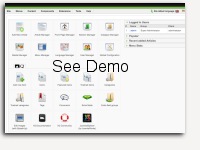Content Management System (CMS)

What's a Content Management System (CMS)?
Content Management System (CMS) is a web-based driven application that allows multiple users with different permission levels to manage (all or a section of) content, data or information of a website without the need to have HTML knowledge..
A major advantage of using a CMS is that it requires almost no technical skill or knowledge to manage. Since the CMS manages all your content, you don't have to.
Here are just a few examples of Web sites
that use CMS:
MTV Networks Quizilla (Social networking) -
http://www.quizilla.com
IHOP (Restaurant chain) - http://www.ihop.com
Harvard University (Educational) -
http://gsas.harvard.edu
The Green Maven (Eco-resources) -
http://www.greenmaven.com
PlayShakespeare.com (Cultural) -
http://www.playshakespeare.com
What is the benefit of CMS?
 Ease of Updating: A Content Management System makes it very easy to update
your website. Simply login to the Admin Control Panel and You can add
content, images, audio and video on a WYSIWYG Editor.
Ease of Updating: A Content Management System makes it very easy to update
your website. Simply login to the Admin Control Panel and You can add
content, images, audio and video on a WYSIWYG Editor.
No Technical Skills Needed: With user -friendly web based
interface, you do not need any HTML coding experience of any kind.
Site Search Capability: All our CMS websites have search functionality built in which enables the user to search any and all information on the website
Access Website From Anywhere: Since Content Management System
is web based interface, any user can access and update the website
anywhere. Simply login to the Admin Control Panel and you are ready to
add or edit the website as required.
Multiple Level User Access: Registration system allows various
types of permissions on what users are allowed to access, edit, publish.
Multiple users of your organization can have different levels of access
to your site, so that they can manage content appropriate for their
position.
What's Included?
- User Management: Registration system that allows users to configure personal options with various types of permissions on what users are allowed to access, edit, publish and administrate.
- Authentication is an important part of user management and it supports multiple protocols, including LDAP, OpenID, and even Gmail. This allows users to use their existing account information to streamline the registration process.
- Media Manager: The Media Manager is the tool for easily managing media files or folders and you can configure the MIME type settings to handle any type of file. The Media Manager is integrated into the Article Editor tool so you can grab images and other files at any time.
- Language Manager: There is international support for many world languages and UTF-8 encoding. If you need your Web site in one language and the administrator panel in another, multiple languages are possible.
- Banner Management: It's easy to set up banners on your Web site using the Banner Manager, starting with creating a client profile. Once you add campaigns and as many banners as you need, you can set impression numbers, special URLs, and more.
- Contact Management: The Contact Manager helps your users to find the right person and their contact information. It also supports multiple contact forms going to specific individuals as well as groups.
- Polls: If you want to find out more about your users, it's easy to create polls with multiple options.
- Search: Help navigate users to most popular search items and provide the admin with search statistics.
- Web Link Management: Providing link resources for site users is simple and you can sort them into categories, even count every click.
- Content Management: Simplified three-tiered system of articles makes organizing your content a snap. You can organize your content any way you want and not necessarily how it will be on your Web site. Your users can rate articles, e-mail them to a friend, or automatically save a PDF (with UTF-8 support for all languages). Administrators can archive content for safekeeping, hiding it from site visitors.
- On public Web sites, built-in e-mail cloaking protects email addresses from spambots.
- WYSIWYG Editor: Creating content is simple with the WYSIWYG editor, giving even novice users the ability to combine text, images in an attractive way. Once you've created your articles, there are a number of pre-installed modules to show the most popular articles, latest new items, newsflashes, related articles, and more.
- Syndication and Newsfeed Management: It's easy to syndicate your site content, allowing your users to subscribe to new content in their favorite RSS reader. It's equally easy to integrate RSS feeds from other sources and aggregate them all on your site.
- Menu Manager: The Menu Manager allows you to create as many menus and menu items as you need. You can structure your menu hierarchy (and nested menu items) completely independent of your content structure. Put one menu in multiple places and in any style you want; use rollovers, dropdown, flyouts and just about any other navigation system you can think of. Also automatic breadcrumbs are generated to help navigate your site users.
Request a FREE QUOTE! Confidential and no obligation!
To get your first assessment of your business needs. please fill out the form or to talk to us in person, call us at
(847) 461-9227 M-F 9:00AM - 6:00PM (CST).





